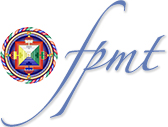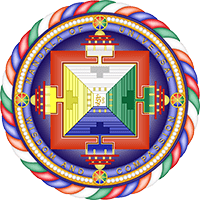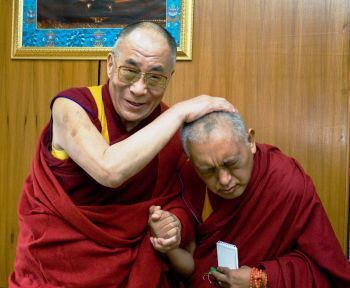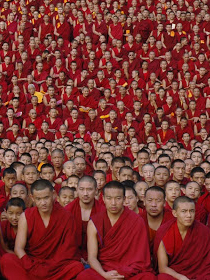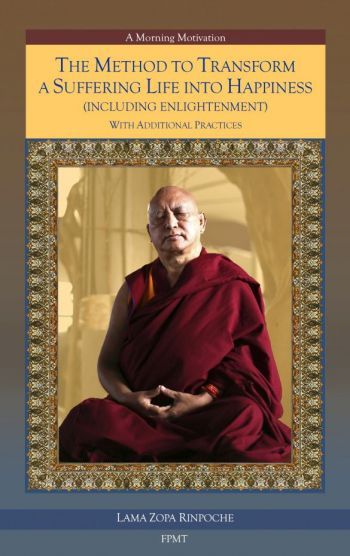- Home
- FPMT Homepage
Foundation for the Preservation of the Mahayana Tradition
The FPMT is an organization devoted to preserving and spreading Mahayana Buddhism worldwide by creating opportunities to listen, reflect, meditate, practice and actualize the unmistaken teachings of the Buddha and based on that experience spreading the Dharma to sentient beings. We provide integrated education through which people’s minds and hearts can be transformed into their highest potential for the benefit of others, inspired by an attitude of universal responsibility and service. We are committed to creating harmonious environments and helping all beings develop their full potential of infinite wisdom and compassion. Our organization is based on the Buddhist tradition of Lama Tsongkhapa of Tibet as taught to us by our founders Lama Thubten Yeshe and Lama Thubten Zopa Rinpoche.
- Willkommen
Die Stiftung zur Erhaltung der Mahayana Tradition (FPMT) ist eine Organisation, die sich weltweit für die Erhaltung und Verbreitung des Mahayana-Buddhismus einsetzt, indem sie Möglichkeiten schafft, den makellosen Lehren des Buddha zuzuhören, über sie zur reflektieren und zu meditieren und auf der Grundlage dieser Erfahrung das Dharma unter den Lebewesen zu verbreiten.
Wir bieten integrierte Schulungswege an, durch denen der Geist und das Herz der Menschen in ihr höchstes Potential verwandelt werden zum Wohl der anderen – inspiriert durch eine Haltung der universellen Verantwortung und dem Wunsch zu dienen. Wir haben uns verpflichtet, harmonische Umgebungen zu schaffen und allen Wesen zu helfen, ihr volles Potenzial unendlicher Weisheit und grenzenlosen Mitgefühls zu verwirklichen.
Unsere Organisation basiert auf der buddhistischen Tradition von Lama Tsongkhapa von Tibet, so wie sie uns von unseren Gründern Lama Thubten Yeshe und Lama Thubten Zopa Rinpoche gelehrt wird.
- Bienvenidos
La Fundación para la preservación de la tradición Mahayana (FPMT) es una organización que se dedica a preservar y difundir el budismo Mahayana en todo el mundo, creando oportunidades para escuchar, reflexionar, meditar, practicar y actualizar las enseñanzas inconfundibles de Buda y en base a esa experiencia difundir el Dharma a los seres.
Proporcionamos una educación integrada a través de la cual las mentes y los corazones de las personas se pueden transformar en su mayor potencial para el beneficio de los demás, inspirados por una actitud de responsabilidad y servicio universales. Estamos comprometidos a crear ambientes armoniosos y ayudar a todos los seres a desarrollar todo su potencial de infinita sabiduría y compasión.
Nuestra organización se basa en la tradición budista de Lama Tsongkhapa del Tíbet como nos lo enseñaron nuestros fundadores Lama Thubten Yeshe y Lama Zopa Rinpoche.
A continuación puede ver una lista de los centros y sus páginas web en su lengua preferida.
- Bienvenue
L’organisation de la FPMT a pour vocation la préservation et la diffusion du bouddhisme du mahayana dans le monde entier. Elle offre l’opportunité d’écouter, de réfléchir, de méditer, de pratiquer et de réaliser les enseignements excellents du Bouddha, pour ensuite transmettre le Dharma à tous les êtres. Nous proposons une formation intégrée grâce à laquelle le cœur et l’esprit de chacun peuvent accomplir leur potentiel le plus élevé pour le bien d’autrui, inspirés par le sens du service et une responsabilité universelle. Nous nous engageons à créer un environnement harmonieux et à aider tous les êtres à épanouir leur potentiel illimité de compassion et de sagesse. Notre organisation s’appuie sur la tradition guéloukpa de Lama Tsongkhapa du Tibet, telle qu’elle a été enseignée par nos fondateurs Lama Thoubtèn Yéshé et Lama Zopa Rinpoché.
Visitez le site de notre Editions Mahayana pour les traductions, conseils et nouvelles du Bureau international en français.
Voici une liste de centres et de leurs sites dans votre langue préférée
- Benvenuto
L’FPMT è un organizzazione il cui scopo è preservare e diffondere il Buddhismo Mahayana nel mondo, creando occasioni di ascolto, riflessione, meditazione e pratica dei perfetti insegnamenti del Buddha, al fine di attualizzare e diffondere il Dharma fra tutti gli esseri senzienti.
Offriamo un’educazione integrata, che può trasformare la mente e i cuori delle persone nel loro massimo potenziale, per il beneficio di tutti gli esseri, ispirati da un’attitudine di responsabilità universale e di servizio.
Il nostro obiettivo è quello di creare contesti armoniosi e aiutare tutti gli esseri a sviluppare in modo completo le proprie potenzialità di infinita saggezza e compassione.
La nostra organizzazione si basa sulla tradizione buddhista di Lama Tsongkhapa del Tibet, così come ci è stata insegnata dai nostri fondatori Lama Thubten Yeshe e Lama Zopa Rinpoche.
Di seguito potete trovare un elenco dei centri e dei loro siti nella lingua da voi prescelta.
- 欢迎 / 歡迎
简体中文
“护持大乘法脉基金会”( 英文简称:FPMT。全名:Foundation for the Preservation of the Mahayana Tradition) 是一个致力于护持和弘扬大乘佛法的国际佛教组织。我们提供听闻,思维,禅修,修行和实证佛陀无误教法的机会,以便让一切众生都能够享受佛法的指引和滋润。
我们全力创造和谐融洽的环境, 为人们提供解行并重的完整佛法教育,以便启发内在的环宇悲心及责任心,并开发内心所蕴藏的巨大潜能 — 无限的智慧与悲心 — 以便利益和服务一切有情。
FPMT的创办人是图腾耶喜喇嘛和喇嘛梭巴仁波切。我们所修习的是由两位上师所教导的,西藏喀巴大师的佛法传承。
繁體中文
護持大乘法脈基金會”( 英文簡稱:FPMT。全名:Found
ation for the Preservation of the Mahayana Tradition ) 是一個致力於護持和弘揚大乘佛法的國際佛教組織。我們提供聽聞, 思維,禪修,修行和實證佛陀無誤教法的機會,以便讓一切眾生都能 夠享受佛法的指引和滋潤。 我們全力創造和諧融洽的環境,
為人們提供解行並重的完整佛法教育,以便啟發內在的環宇悲心及責 任心,並開發內心所蘊藏的巨大潛能 — 無限的智慧與悲心 – – 以便利益和服務一切有情。 FPMT的創辦人是圖騰耶喜喇嘛和喇嘛梭巴仁波切。
我們所修習的是由兩位上師所教導的,西藏喀巴大師的佛法傳承。 察看道场信息:
- FPMT Homepage
- News/Media
-
- Study & Practice
-
-
- About FPMT Education Services
- Latest News
- Programs
- New to Buddhism?
- Buddhist Mind Science: Activating Your Potential
- Heart Advice for Death and Dying
- Discovering Buddhism
- Living in the Path
- Exploring Buddhism
- FPMT Basic Program
- FPMT Masters Program
- FPMT In-Depth Meditation Training
- Maitripa College
- Lotsawa Rinchen Zangpo Translator Program
- Universal Education for Compassion & Wisdom
- Online Learning Center
-
- Prayers & Practice Materials
- Overview of Prayers & Practices
- Full Catalogue of Prayers & Practice Materials
- Explore Popular Topics
- Benefiting Animals
- Chenrezig Resources
- Death & Dying Resources
- Lama Chopa (Guru Puja)
- Lama Zopa Rinpoche: Compendium of Precious Instructions
- Lama Zopa Rinpoche: Life Practice Advice
- Lama Zopa Rinpoche Practice Series
- Lamrim Resources
- Mantras
- Prayer Book Updates
- Purification Practices
- Sutras
- Thought Transformation (Lojong)
- Audio Materials
- Dharma Dates - Tibetan Calendar
- Translation Services
- Publishing Services
- Ways to Offer Support
- Prayers & Practice Materials
-
- Teachings and Advice
- Find Teachings and Advice
- Lama Zopa Rinpoche Advice Page
- Lama Zopa Rinpoche: Compendium of Precious Instructions
- Lama Zopa Rinpoche Video Teachings
- ༧སྐྱབས་རྗེ་བཟོད་པ་རིན་པོ་ཆེ་མཆོག་ནས་སྩལ་བའི་བཀའ་སློབ་བརྙན་འཕྲིན།
- Podcasts
- Lama Yeshe Wisdom Archive
- Buddhism FAQ
- Dharma for Young People
- Resources on Holy Objects
- Teachings and Advice
-
-
*If a menu item has a submenu clicking once will expand the menu clicking twice will open the page.
-
-
- Centers
-
- Teachers
-
- Projects
-
-
-
-
*If a menu item has a submenu clicking once will expand the menu clicking twice will open the page.
-
-
- FPMT
-
-
-
-
-
However the very bottom line is to do all ones actions with bodhichitta. That is the best, the most meaningful way to think during your break time. This makes your life most beneficial. As much as possible with awareness keep ones attitude and thoughts in bodhichitta, the thought of benefiting others, try to do all the activities with that mind, including doing your job and throughout the day. This way even in your break time whatever you do becomes the cause of happiness.
Share
Lama Zopa Rinpoche
-
-
-
- Shop
-
-
-
The Foundation Store is FPMT’s online shop and features a vast selection of Buddhist study and practice materials written or recommended by our lineage gurus. These items include homestudy programs, prayers and practices in PDF or eBook format, materials for children, and other resources to support practitioners.
Items displayed in the shop are made available for Dharma practice and educational purposes, and never for the purpose of profiting from their sale. Please read FPMT Foundation Store Policy Regarding Dharma Items for more information.
-
-
24
If you wish to read FPMT International Office’s May 24 update regarding Dagri Rinpoche, it is available here.
Lama Zopa Rinpoche felt strongly that it was important for him to offer the following advice to the students of Dagri Rinpoche out of concern for their guru-disciple relationship. Rinpoche also offered advice on guru devotion to all students.
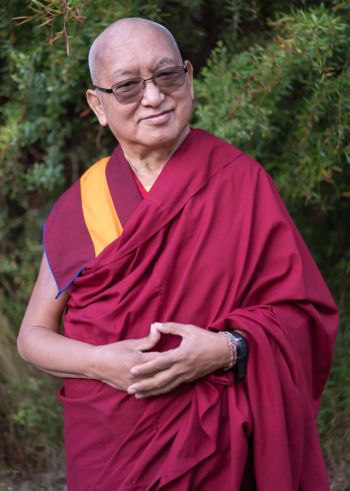
Lama Zopa Rinpoche, Adelaide, Australia, May 2018. Photo by Ven. Lobsang Sherab.
Many people who have studied Dharma know this, but other people may not know this: In the Lesser Vehicle teachings the ten non-virtues cannot become virtue by depending on the motivation. If the action happened, then it is just non-virtue. But it’s different in Mahayana Buddhism if the three non-virtuous actions of the body and the four non-virtuous actions of the speech are done with unbelievably strong compassion. For example, if you prefer to be born in hell yourself instead of another sentient being being born in hell, you will not be born in hell. You are able to choose like that. For bodhisattvas, to achieve the blissful state of peace, or nirvana, for oneself is extremely dirty. In the texts it says that it is like spit or snot thrown away on a road. I use the example of used toilet paper with kaka on it—you immediately throw it away. It is like that for a bodhisattva’s holy mind. But to be born in hell for sentient being, to be able to save sentient beings, is like a swan entering a pond. The swan is so happy to enter the pond. It is the most happy, most exciting thing; it is what they really want. So, it is like that for a bodhisattva’s holy mind. That is the example given in the texts.
There is the story of the bodhisattva captain. A long time ago, way back when Shakyamuni Buddha was a bodhisattva, he was the captain of a ship. One man on the ship, who was short and carrying a spear, wanted to kill the 500 other people on the boat. Knowing this, the bodhisattva captain felt unbelievable compassion because the man would then be reborn in the lower realms and suffer for eons. The bodhisattva captain really wanted to be born in hell himself and not the man. So, with that mind of unbelievable compassion, wanting to protect the man from negative karma and from many eons of suffering in the hells, he then killed the man. The effect of doing that, because it was done with such unbelievable compassion, was to cause the bodhisattva captain to be 100,000 eons closer to enlightenment and to being free from samsara. It became an unbelievable purification. This was because the motivation of unbearable compassion made the action not only become Dharma but the cause of enlightenment.
Then the Vajrayogini commentary tells how Nagpo Chopa, the guru, was going to practice tantric conduct (the last practice just before enlightenment) in a place called Oddiyana, near Buxa, in India, where I lived for eight years. Waiting near a big river was a woman who had leprosy, with pus and blood coming out of her. She was totally, unbelievably dirty. The leper woman asked Nagpo Chopa to please carry her on his back across the river, but he didn’t answer her and just went straight across the river. After some time his disciple, Getsul Tsembulwa, who was not a full bhikshu, came by, and she asked him to carry her across to the other side of the river. When he saw her, unbelievable compassion immediately arose within him. Without any thought of the contagious disease or of being a monk, but with only unbelievable compassion, he immediately carried her on his back across the river. When he reached the middle of the river, his heavy negative karma that prevented him from seeing her as the enlightened being Dorje Phagmo and made him only see her as a terrible, dirty, and sick was purified. That ordinary appearance finished because his negative karma was purified. The mind that projected that ordinary appearance was gone, purified. So, that woman was Dorje Phagmo, who then took Getsul Tsembulwa to the pure land of Dagpa Kachoe (the Vajrayogini pure land), in his same body, without his needing to die first. Since one definitely becomes enlightened there in Dagpa Kachoe, he probably became enlightened earlier than his guru, Nagpo Chopa. This was because he generated unbelievable compassion.
Another example is from Asanga’s life story—many people know this story. Asanga spent twelve years in retreat trying to achieve Maitreya Buddha. He left after every three years of retreat, and different conditions happened that inspired him each time to go back into retreat. One time he saw a bird flying in and out of a cave to its nest. The bird’s wings were so soft, but where they touched the rock was being worn down. That inspired Asanga so much that he thought he would go back into retreat to try to achieve Maitreya Buddha. When he came down after another three years, he saw a thread being used to cut hard rock. Over time they were able to cut the rock with just a tiny thread. Again that inspired him to go back into retreat. Three years later when he came down, he saw water dripping onto a rock—one, two, three drops—and the rock was being worn down, with a hole starting to form. This again inspired him and he went back into retreat.
Still nothing happened, and after three years he again left the retreat. As he was walking down the road, he saw a wounded dog, the lower part of whose body was totally full of maggots. Asanga cut a piece of flesh off his thigh to put the maggots on, so they had something to eat. Since he didn’t want to harm the maggots by picking them up with his fingers, he closed his eyes and stretched out his tongue, intending to pick them up with his tongue. But he could not touch them. When he opened his eyes, there was no longer a wounded dog but Maitreya Buddha.
Asanga then complained, saying, “Why didn’t I see you during the retreat?” Maitreya Buddha said, “I was there with you. Look at your spit on my robes.” To prove it, he showed the marks on his robes where Asanga had spat. Asanga then requested teachings, and Maitreya Buddha took him to Tushita pure land, Yiga Chozin, and gave him the five divisions of teachings (Jangchub Denma). One morning in Tushita pure land is equal to fifty human years. Asanga then came back and wrote the five commentaries. From that, so many people have done listening, reflecting, and meditation, achieved the path and become enlightened. (Of course, later in Tibet, Lama Atisha wrote The Lamp of the Path to Enlightenment, which again so many people in the world have studied and thus subdued their mind and achieved enlightenment. This came from Nalanda in India.)
In the great monasteries in Tibet, people studied and took these teachings for many years. Then nowadays many nuns in nunneries, including the Kopan nunnery, have also been studying these teachings. They are all unbelievably fortunate to learn Buddhadharma in such an extensive way. They are very fortunate to learn how to generate the path and how to achieve enlightenment.
These are just a few examples of the results of Asanga’s great compassion. All these benefits received by so many sentient beings, which we have also been receiving, came from Asanga’s great compassion.
We have to have expansive knowledge and understanding. For example, according to the Mahayana, while Guru Shakyamuni Buddha was showing enlightenment in this world, in another world he was showing descending from Tushita; then at the same time, in another world he was showing conception; then in other worlds he was showing teaching the Dharma or subduing the maras. All these different things were happening at the same time. But according to Theravadin Buddhism, when Buddha showed enlightenment in Bodhgaya, it was the first time he was enlightened.
Even though there is need for laws in a country and vinaya rules in a monastery, it is your own practice to subdue your mind. Buddha said: “Do not commit any unwholesome action; engage in wholesome actions; and subdue your own mind.” If subduing your own mind is missing, then you are not practicing real Buddhism. Externally it looks like you are practicing Buddhism, but inwardly you are not practicing Buddhism.
There are similar cases in the monasteries, where there is the study of the major philosophical texts: you study Dharma outwardly, but are not studying Dharma inwardly. Therefore, you don’t find happiness from Buddhism. You have the same problems in your mind that you had even before you met Buddhism—maybe even worse problems. You then spend your life creating negative karma by criticizing others all the time. I wonder why Buddha said, “Subdue your own mind”?
In the practices of Sangha there is a practice called ge jong je sho she. It means that if somebody is angry with you, you don’t get angry back; if somebody shouts at and scolds you, you don’t do that back; if somebody beats you, you don’t beat them back; if somebody provokes you, you don’t provoke them back. Otherwise, it is like there is no purpose in Buddha teaching us to subdue our own mind.
My greatest interest is: Are there sentient beings who have been pure from beginningless rebirths, with no disturbing-thought obscurations and no subtle obscurations? Are there any sentient beings like this other than my gurus? Are there any sentient beings whose minds have been totally pure, with no mistakes, no disturbing-thought obscurations and no subtle obscurations, from beginningless rebirth? That is what I am wondering.
No matter what people in the world say to criticize Dagri Rinpoche, I keep my mind in the understanding that this is a holy being. I don’t become like a cow with a rope tied through its nose that is led around by people and has to go wherever the people pull it. Even though I am extremely ignorant of the world and I have no understanding of Dharma, I have this slight wisdom and I stay with that. This is a holy being, not an ordinary being, as I mentioned before.
Somebody who practices patience and has unbelievable compassion in return to anger or harm receives unbelievable benefits from that, up to enlightenment. Those who don’t practice holy Dharma get angry. You can see that it totally depends on the person’s mind, on what label the person puts on that: harm or benefit, negative or positive. You can use it whichever way you like, for delusion or not. Those actions make some people so happy; even for attachment it makes them so happy. Some people who are not interested at that time, who don’t like it, get angry back. Even in regard to delusions, it is like that. It depends on whether you like or dislike something. If you like it, then you are so happy; if you dislike it, then you get so angry. Even with delusion it depends on which label you put, like or dislike. So, it comes from the person’s mind. So much depends on the mind of the person, of the perceiver, who judges something as good or bad. It is the same with kaka. For human beings it is something to throw out, but for dogs and even pretas, kaka is what they need, what they enjoy. It is the same with durian. Some people like durian so much, but others hate it. So, it’s up to a person’s karma, and even the same person might like or dislike something at different times.
In regard to investigating, in my understanding, is the investigation of today? Of this year or last year? From his childhood? From when he was conceived in his mother’s womb? Should the investigation be of his past life? In his past life Dagri Rinpoche was Pari Dorje Chang, a very famous lama in Lhasa, and Lama Yeshe’s guru. He gave the oral transmission of the Kangyur in the large monasteries in Tibet. Or should the investigation be of the life before that? Should the investigation be from beginningless rebirths? Then we will be investigating endless samsara. We will have to achieve enlightenment in order to investigate the beginningless rebirths of Dagri Rinpoche. We have to be enlightened; otherwise, we can’t investigate. This is my logic.
Here, it seems that only Rinpoche is wrong and all of us are totally pure, have never engaged in non-virtue. It becomes like that. In Rinpoche’s case, this is all I have to say. I have nothing else to say.
This case doesn’t apply only to Dagri Rinpoche. People bring up everyone in the world as having mistakes. People even criticize His Holiness the Dalai Lama, because His Holiness gives advice on the shortcomings of following dolgyal, which some people believe is a Dharma protector. This advice comes from His Holiness’s own experience, over a long time, over years and years. Others hide the mistakes and don’t reveal them publically because people will criticize them. But His Holiness has unbelievable compassion, so instead of hiding the truth he revealed it. His Holiness showed what is true and what is false, what is harmful and what is helpful.
Not only His Holiness the Dalai Lama but many high lamas in Tibet stopped the practice of dolgyal, such as:
- 54th Ganden Tripa Trichen Ngawang Chogden – Regent of Lama Tsongkhapa, he advised to not have it in the constitution of the monastery, to not practice it.
- Purchog Ngawang Jampa (an incarnation of Maitreya Buddha and a great Sera lama)
- 8th Dalai Lama Gyalwa Jampa Gyatso
- Yongdzin Yeshe Gyaltsen
- Thuken Chokyi Nyima
- Changkya Rolpai Dorje
- Yangchen Drupai Dorje
- Ngulchu Dharmabhadra
- Lama Chosang Chokyi Nyingje
- Dodrup Jigme Tenpai Nyima
- Jamyang Khyentse Wangpo
- 8th Panchen Lama Tenpai Wangchuk
And there are many others, great lamas who brought extensive benefit to sentient beings and the teachings of Buddha, like the sun and moon in the world. All these great lamas advised to not do the practice, even putting it in the constitution of the monasteries. It’s not just the view of His Holiness the Dalai Lama, who protects us sentient beings and guides us with so much compassion.
It’s very important to study the advice of those lamas, which was given a long time ago in Tibet. In general, people don’t have much idea. They think it’s only His Holiness. Then, depending on what they like and don’t like, they then criticize His Holiness. But they don’t follow the analysis of whether it is a harmful thing or a helpful thing. They don’t check that.
Then, in the twenty-first century, those, such as myself, with very, very obscured ordinary minds, who are very ignorant and without the wisdom to analyze things, should then say that great enlightened Heruka Kyabje Pabongka; Kyabje Trijang Rinpoche, my root guru; Kyabje Zong Rinpoche; Geshe Rabten and Lama Yeshe didn’t practice dolgyal, but showed the aspect of practicing dolgyal. In the section on perfectly following the guru, there is the word “tsul,” which means showed the aspect. They showed the aspect; they acted that way, but it was not real. So, for me and the twenty-first century sentient beings, whose minds are so obscured and so ignorant, with no wisdom to check whether it is helpful or harmful, they appeared to practice, but actually they did not practice. It was an act.
When Bodhisattva Meaningful to Behold asked Buddha, “Now we are guided by you, but in the future who will guide us?” Buddha replied, “Hi, I will reveal birth, old age, sickness, and death in order to ripen the minds of sentient beings.”
In brief, I mention this quotation of what Buddha said. Even arhats, who are free from delusion and karma and samsara, do not have birth, old age, sickness, and death, so how is it possible for Buddha to have them?
I am talking about this on the basis of not even having met Pabongka Dechen Nyingpo, but I have read a lot of his teachings, so on the basis of that, from my side, they are all Buddha.
So, it depends on what you like and don’t like. In this instance, people criticize His Holiness the Dalai Lama. If it is opposite to what you like, then you criticize. People do that. Even Buddha was criticized by the Hindu followers.
Then it becomes that nobody is enlightened. It comes to that point. Then the whole of the teachings are not true. Even nowadays, even recently, in the past years, so many beings achieved seeing the guru as buddha, renunciation, bodhichitta, right view, and tantric realizations of the generation and completion stages. It is happening even now. Even we ourselves find that when we read lamrim our problems go away; our mind becomes peaceful. You can see the logic of what Buddha said: “Mighty Ones, Bhikshus, learned ones, check my teachings like one examines gold by burning, cutting, and rubbing. One then sees refined gold. Take the teachings in the same way, not by blind faith.”
So, that is not only for beginners, for Westerners in particular, but includes even learned lamas and geshes with many disciples. In Tibet, many valid high lamas, such as Kyabje Ling Rinpoche and many others, even though they were followers of and extremely devoted to Pabongka Rinpoche, did not practice dolgyal.
I deeply apologize if my previous advice caused any unhappiness. Whichever way you speak, it causes unhappiness to different people. Of course, in the world, even if somebody does a really positive thing, there are people who take that as very negative; then somebody does a very negative thing and some people take it as very positive. So, it is like that. I want to say that I am deeply sorry about all the people who got hurt from Rinpoche’s holy actions.
So, this is additional clarification of my previous advice to students of Dagri Rinpoche.
Thank you very much for your understanding, and thank you very much for spending your precious human life and precious time reading my blah, blah, blah.
Lama Zopa
Institut Vajra Yogini, Marzens, France
Scribed by Holly Ansett, May 19-21, 2019; edited by Ailsa Cameron.
Find Rinpoche’s May 14 advice for students of Dagri Rinpoche here.
FPMT International Office’s updates regarding Dagri Rinpoche are available here:
https://fpmt.org/fpmt/announcements/updates-regarding-dagri-rinpoche/
- Home
- News/Media
- Study & Practice
- About FPMT Education Services
- Latest News
- Programs
- New to Buddhism?
- Buddhist Mind Science: Activating Your Potential
- Heart Advice for Death and Dying
- Discovering Buddhism
- Living in the Path
- Exploring Buddhism
- FPMT Basic Program
- FPMT Masters Program
- FPMT In-Depth Meditation Training
- Maitripa College
- Lotsawa Rinchen Zangpo Translator Program
- Universal Education for Compassion & Wisdom
- Online Learning Center
- Prayers & Practice Materials
- Overview of Prayers & Practices
- Full Catalogue of Prayers & Practice Materials
- Explore Popular Topics
- Benefiting Animals
- Chenrezig Resources
- Death & Dying Resources
- Lama Chopa (Guru Puja)
- Lama Zopa Rinpoche: Compendium of Precious Instructions
- Lama Zopa Rinpoche: Life Practice Advice
- Lama Zopa Rinpoche Practice Series
- Lamrim Resources
- Mantras
- Prayer Book Updates
- Purification Practices
- Sutras
- Thought Transformation (Lojong)
- Audio Materials
- Dharma Dates – Tibetan Calendar
- Translation Services
- Publishing Services
- Teachings and Advice
- Find Teachings and Advice
- Lama Zopa Rinpoche Advice Page
- Lama Zopa Rinpoche: Compendium of Precious Instructions
- Lama Zopa Rinpoche Video Teachings
- ༧སྐྱབས་རྗེ་བཟོད་པ་རིན་པོ་ཆེ་མཆོག་ནས་སྩལ་བའི་བཀའ་སློབ་བརྙན་འཕྲིན།
- Podcasts
- Lama Yeshe Wisdom Archive
- Buddhism FAQ
- Dharma for Young People
- Resources on Holy Objects
- Ways to Offer Support
- Centers
- Teachers
- Projects
- Charitable Projects
- Make a Donation
- Applying for Grants
- News about Projects
- Other Projects within FPMT
- Support International Office
- Projects Photo Galleries
- Give Where Most Needed
- FPMT
- Shop
Translate*
*powered by Google TranslateTranslation of pages on fpmt.org is performed by Google Translate, a third party service which FPMT has no control over. The service provides automated computer translations that are only an approximation of the websites' original content. The translations should not be considered exact and only used as a rough guide.If you don’t know your own psychology, you might ignore what’s going on in your mind until it breaks down and you go completely crazy.
